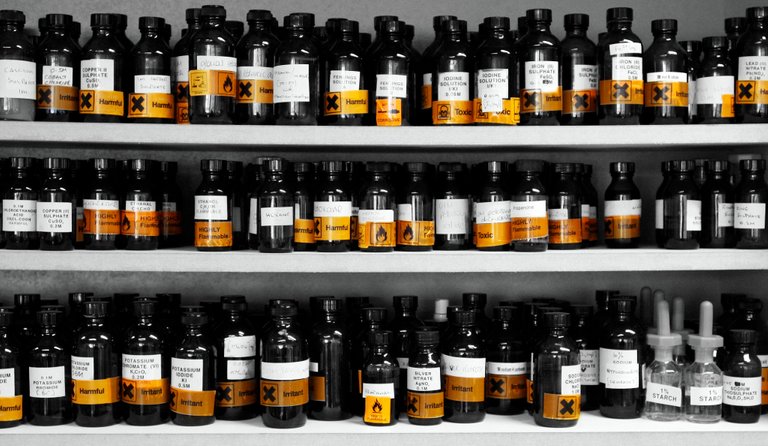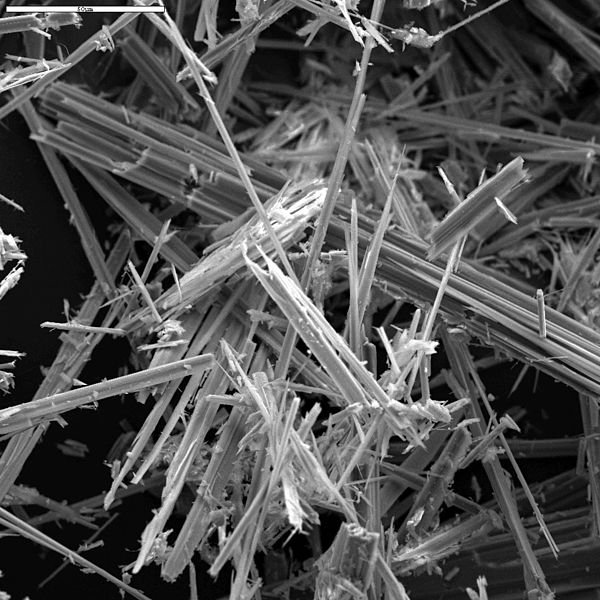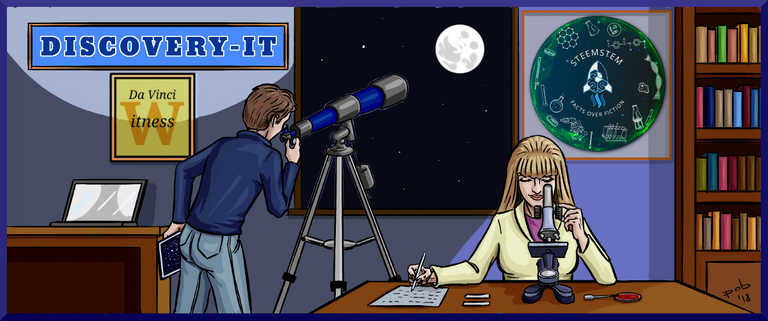Chemicals as a cause of disease / Sostanze chimiche come causa di malattia

Introduction
The chemicals are many, heterogeneous, both from the structural point of view, and from the point of view of their distribution in the environment that surrounds us.
Their heterogeneity also affects the pathogenic effects, which are therefore very heterogeneous. An example of this is the fact that there is not an organ that is not affected by one or another chemical substance; not even the brain escapes this type of etiological agent, despite the presence of the blood-brain barrier, which protects the brain from many chemicals; some manage to overcome this obstacle and also alter the brain.
Many chemicals have a dual mechanism of action, which makes their pathogenesis more complex, and can give both local and systemic effects. They can also have acute (short-term) and chronic (long-term) effects; in most cases the long-term effects correspond to the onset of cancer, as many chemicals are carcinogenic.
The long-term effects of exposure to carcinogenic chemicals can also occur after decades.
It is therefore a long, insidious and asymptomatic pathogenesis, which in the past has made it extremely difficult to associate a tumour with a chemical etiological agent with which it had come into contact decades earlier.
Short/medium term effects can be used for the prevention or early diagnosis of the onset of long-term effects. Many carcinogenic chemicals, in fact, before giving cancer, give short-term symptoms, less serious, but indicative of the fact that that subject, if it has developed the short-term effects is at risk of cancer over decades.
These short-term symptoms are the so-called preneoplastic lesions, widely used in oncology, and which have had a huge impact on the treatment and prevention of cancer.
One example is the Pap test, to which all women are subjected, which looks for preneoplastic lesions, which are equivalent to dysplasia of the epithelium of the cervix and uterus. These dysplasias are preneoplastic signs, indicating a greater likelihood of developing neoplasm in the future, than a woman who does not show these lesions.
Another example is the non-specific presence of chronic bronchitis in avid smokers; it is not a preneoplastic lesion, but the presence of chronic bronchitis directs the doctor to further investigations, which consist of a biopsy or analysis of the sputum of the smoking patient. The diagnostic path is therefore: history (the patient is a fierce smoker), presence of chronic bronchitis, then proceed to a bronchial biopsy and finally probable diagnosis of bronchial metaplasia. Bronchial metaplasia consists of a loss of the characteristic respiratory ciliate epithelium, which becomes floor-like. This is a preneoplastic lesion, which indicates that the patient may develop a tumor in the future either at the bronchial or at the pulmonary level.
Classification by pathogenic potentiality

Chemicals can have different pathogenic potential, i.e. their pathogenic mechanism can be very different. They can be:
Phlogogens: determine inflammation, i.e. a reaction for defensive purposes which, if not adequately controlled, can become pathological itself. An abnormal inflammation is therefore a pathogenetic mechanism.
Toxic: a toxic substance is defined as a substance that is able to interfere with a precise molecule of our organism (e.g. with a particular enzyme, a receptor, a structural protein, ...).
The term "toxic" always indicates an extremely precise pathogenetic mechanism. The fact that these substances interact and block a single molecule in our body does not mean that its effects are necessarily mild; in fact, they can also have lethal effects.Mutagenic: they can give or hereditary diseases, if they affect the egg cell or the spermatozoon, in this case the child of the couple could develop a genetic disease, or they can give cancer if they affect the somatic cells of an adult individual. The term "mutagen" is inextricably linked to the term "carcinogenic", in fact in the pharmaceutical, cosmetic or food industries, when a new molecule is developed at a commercial level to be administered to humans, the first test to be carried out is that of mutagenicity: if the molecule is mutagenic it does not need further investigation, because it is potentially carcinogenic and therefore must be forgotten.
However, the concept that a carcinogenic substance is always mutagenic does not apply. There are, in fact, substances which, although they are not mutagenic, that is, substances which are not able to enter the cell, enter the nucleus, bind themselves to the DNA and modify it, can still cause cancer.
- Theratogen: substances that interfere with embryonic development and promote the development of tumours in the embryo or fetus.
Some substances are apparently harmless by contact or inhalation; this means that coming into contact with the skin or inhaling these substances, even in large quantities, will have no effect anyway. This does not mean that the substance is harmless, because there is always the possibility that, once it has reached some particular organs, called transformation organs, which correspond to the gastro-intestinal apparatus, but above all to the liver, they are activated and develop their pathogenic action.
Why has our liver developed the ability to make harmless chemicals pathogenic?
A first reason is that the liver has evolved in environments free of neosynthetic chemicals, so it has not developed in order to detoxify these substances. In general, when the liver comes into contact with exogenous molecules, it has the task of eliminating them. The ways of eliminating exogenous substances are: faeces, urine and sweat. All three of these methods are characterized by excretion in an aqueous environment, so a chemical substance to be eliminated must be water-soluble.
Due to their heterogeneity, there are also many chemicals that are not water-soluble, but hydrophobic or lipophilic. The liver is responsible for processing these lipophilic substances and making them hydrophilic.
Example: the Benzopyrene, which forms when, for instance, we burn the meat on the embers, is a big lipophilic molecule, formed by the condensation of several benzene rings, to which is added an hydroxyl group, in order to make it hydrophilic, so that it can be eliminated by urine or sweat.
The problem is that by attaching electrical charges to molecules, whether negative or positive, they become able to interact with DNA, mainly in liver cells, where the substance to be eliminated has accumulated and been transformed. Lipophilic molecules, on the other hand, do not interact with DNA but dissolve in the lipids of cell membranes.
Classification of pathogenic chemicals
It is very difficult to classify pathogenic chemicals on a chemical or medical basis because of their heterogeneity. An effective classification is the subdivision according to their distribution in the environment.
There are several ways in which you can come into contact with pathogenic chemicals, some of which are common to all those living in polluted cities and others that affect increasingly narrower categories of people. The categories into which the pathogenic chemicals are divided are:
Atmospheric pollution
It affects everyone, especially developing countries such as India and China, where pollution is high. The main pathogenic chemicals in the atmosphere are carbon monoxide (CO), carbon dioxide (CO2), sulphur oxide (SO2) and nitrogen oxide (NO), very simple and apparently harmless molecules. SO2 and NO, together with fine particles are monitored by appropriate stations, to decide whether the pollution is at a guard level or not.
In the atmosphere we also find very complex neosynthetic substances and corpusculated material (fine dust), which can no longer be defined as chemical substances, but as microscopic objects with a particular mechanism of pathogenicity. It consists in concentrating other pathogenic substances on the surface, i.e. they act as an amplifier of other known chemical substances and absorb them.
All these chemicals are released into the atmosphere by industrial processes and by combustion by transport and heating. When the stations detect too high levels of nitrogen oxide, sulphur oxide and corpuscular material, the mechanisms of alarm and protection can be: the blocking of motor vehicles, the waiting for rain or wind to change the air, or raise the levels of danger.

Pollution of water and soil
Two main categories of substances can be found in soil and water:
Neosynthetic substances: insecticides, herbicides, rodenticides, fungicides (particular forms of herbicides), and other substances used in intensive agriculture.
oligoelements such as lead, mercury, cadmium and chromium. They have always existed in nature and are present in the body only in traces. A series of industrial processes, carried out by man, ensures that in a geographical area, generally where industry is present, a particular element can be concentrated.
Trace elements are released and concentrated in the environment by industrial processes such as the production of paints, solvents, paper mills and pharmaceutical industries.

Anecdotes of Correlations between Pathology and Environment
Bay of Minamata
In the 70s in Japan, in the small bay of Minamata, where the water was not changed, was installed a paper mill that used mercury to whiten the paper.
Mercury was released as waste in the bay, fishermen fished the fish in the bay, the main livelihood of the area, and the population began to show pathologies associated with mercury, among which the main one was genotoxicity.
Children born at that time all suffered from severe malformations and adults showed neurological syndromes due to acute mercury poisoning.

Roman Empire
The Romans had a predilection for aqueducts and the pipes that carried the water were initially covered with copper.
However, copper releases metal residues that made the water acidulous, which is why it was replaced by lead, a neurotoxic element, which unlike the previous metal made the water fresh.
Over the centuries, lead accumulated in the brain, especially in the rich, who had houses with running water. It is supposed that the neurological and intellectual decline of the ruling class caused by a high plumbemia made the Roman Empire decadent and weakened in the face of the upper hand of the barbarians.

Industrial pollution and occupational risk
Air pollution and soil and water pollution affect all those living in the same environment. However, there are also categories of pathogenic chemicals that affect a smaller group of people. Usually these are chemical agents used in particular work environments and cared for by a specific category of doctors, those who deal with occupational medicine, whose task is to analyze the possible risks and diseases that can be created in the work environment.
Also in this category we find two types of substances:
Organic substances: neosynthesis substances such as polycyclic hydrocarbons (benzene), aromatic compounds, aliphatic compounds, aromatic amines and volatile anaesthetics (hospital environment).
Inorganic substances: it is not necessary to think only of molecules, but also of objects, as we speak of glass fibres or iron, macroscopic objects. For these substances it is difficult to think of a precise pathogenetic process, because they are much larger, sometimes even larger than the cells. We are therefore talking about non-specific damage, because we are dealing with blunt microobjects that, when inhaled, damage the cells with which they come into contact, the most striking case was the case of 'asbestos or asbestos that I told in a previous article at the following link
storia dell' amianto il denaro uccide
The main target of these substances is the bronchial epithelium and the epithelial cells of the pulmonary alveoli. Cell death caused by the damage of the causative agent induces inflammation, necrosis, inflammation and an attempt to repair the epithelium. In the short or medium term, the subject manifests bronchitis, pneumonia, which will be chronic, because being substances present in the workplace, will be in contact with the subject for a long period of time.
Inorganic substances also have long-term effects. An iron fibre kills a bronchial cell and the surrounding cells proliferate to repair the damage. Once the integrity of the epithelium is restored, the cells stop proliferating, thanks to contact inhibition. Since these substances are present in the workplace, they will be inhaled by the individual for a long period of time, assuming 5 days a week for years, then the bronchi will be subjected to enormous damage, which corresponds to a huge repair process.

This person's lung cells will become labile cells, having to proliferate continuously to repair the damage that continues to be induced by inhaled fibers. Labile cells are more genetically unstable, as they are characterized by a shorter interphase, so any type of mutation is repaired with less probability having a shorter time available to activate the restorative enzyme complex. The individual, however, in the meantime that the cell divides, can also come into contact with other carcinogenic substances, present in the air or in water, and is more subject to the development of tumors at the bronchial or pulmonary level.
It is not iron oxide that induces the mutation, as it is not mutagenic, but it has made the bronchial and pulmonary epithelium more sensitive to the action of a mutagenic substance.
Iron fibre is an example of a promoting substance, it is substances that are not mutagenic in themselves but that predispose to the onset of tumours. One of the main mechanisms of action of this type of substance is to continue to induce cellular damage, inflammation and thus continuous repair, which makes the cells more unstable genetically.
Domestic pollution
Presence of detergents, disinfectants and insecticides in large quantities;
Storage of combustion gases (carbon monoxide) ;
Accumulation of gas from passive smoking, due to the presence of avid smokers;
Accumulation of radon gas. Radon is a trace element, a natural radioactive gas always present in the environment. In karst areas, the cracks in the rocks release this gas, which is contained within the earth's crust, and can accumulate in houses, especially in cellars, in very large quantities, resulting in danger.
Individual contamination
cosmetic treatments: nowadays, before being put on the market, cosmetics must undergo a wide range of toxicity studies and animal tests, in fact there is no way to be sure of the safety of drugs, but also of cosmetics, without carrying out animal tests. Pathologies due to cosmetic products are limited to cases of individual allergies, generally referred to as skin diseases.
abuse of drugs: even when using the drug correctly, under doctor's supervision, side effects may occur, which may become pathologies. Almost all drugs as a contraindication have liver problems and kidney problems, because the drug is transported to the liver to be detoxified and then to the kidney to be eliminated.
Individual voluptuous contamination: abuse of smoking, alcohol and drugs
Examples of pathogenic pathways Carbon monoxide
Pollution of the atmosphere
Substance: carbon monoxide (CO). It is a very simple molecule, released into the atmosphere by incomplete oxidation of fossil fuels and under conditions of heavy traffic CO levels of 100-400 ppm can be reached.
.Pathogenetic process: CO is a toxic substance capable of entering the body and binding a single specific molecule, hemoglobin. CO competes with oxygen for binding to hemoglobin, and being 200 times more akin to oxygen hemoglobin, it is able to undermine oxygen and bind to the protein. Oxygen has a low affinity for hemoglobin and continues to bind and detach, in particular it binds when the partial pressure of oxygen is high, but at a peripheral level, where the partial pressure is low, it is spontaneously released. The carbon monoxide, with an affinity 200 times higher, is able to bind to the haemoglobin and does not detach any more. In this way, it is as if there were a right amount of hemoglobin in the body, but a proportion of this protein was functionally absent.
Affected organs: blood. After 8 hours at 80 parts per million, the individual loses the ability to transport oxygen from the blood by about 15%, which is equivalent to the loss of half a liter of blood.
Pathological manifestations: tissue hypoxia.
Carbon monoxide poisoning is more intense in people who smoke, because in tobacco combustion there is a high amount of CO. The tissue hypoxia of an avid smoker becomes evident when there is a higher functional demand, for example when the smoker goes much faster into oxygen debt than a non-smoker. CO poisoning can cause death by huge accumulation of gas, due to a malfunction of a boiler, a fireplace or in cases of attempted suicide using the exhaust gas of a car.

Examples of pathogenic pathways: Sulphur oxide
Substance: Sulphur Oxide (SO2). Released to the environment due to incomplete oxidation of fossil fuels.
Processing: Sulphur dioxide is not pathogenic, but may be converted into sulphuric acid in the atmosphere spontaneously or in greater quantities in the respiratory system. SO2 in the presence of oxygen becomes SO3, which in the presence of water becomes H2SO4 (sulphuric acid).
Organs affected: O2 and water are very concentrated in the bronchi and lungs in the form of water vapour, so sulphur oxide in the lungs and bronchial area readily turns into sulphuric acid. It is a substance capable of directly damaging the cells, inducing necrosis, which evokes abnormal and chronic inflammation.
Pathological manifestations: causes asthmatic attacks, pulmonary emphysema, lung cancer and chronic bronchitis. Sulfuric acid is able to determine the onset of lung cancer in the same way as iron fibers seen above. Sulphuric acid can be inhaled directly into the work environment and in this way directly involves the nasal and oral mucosa, before it affects the bronchi and lungs.
Pulmonary emphysema
Under physiological conditions, the O2/CO2 exchange surface is enormous; the larger the surface area, the more efficient the oxygen exchange is. This huge surface in such a small space is achieved thanks to the special structure of the alveoli.
Sulphuric acid causes damage to the wall of the alveoli, which fuse together to form a single large cavity, causing the exchange surface to be significantly smaller than the physiological surface. In this way, respiratory insufficiency manifests itself, which can only be counteracted by increasing the amount of oxygen. However, this is a palliative treatment, as it is too late to eliminate the etiological agent.


Introduzione
Le sostanze chimiche sono moltissime, eterogenee, sia dal punto di vista strutturale, che dal punto di vista della loro distribuzione nell’ambiente che ci circonda.
La loro eterogeneità si ripercuote anche sugli effetti patogeni, che sono quindi a loro volta molto eterogenei. Un esempio di ciò è il fatto che non c’è un organo che non sia interessato da una o da un’altra sostanza chimica; neanche il cervello sfugge a questo tipo di agenti eziologici, nonostante la presenza della barriera ematoencefalica, che protegge il cervello da molte sostanze chimiche; alcune riescono a superare questo ostacolo ed alterare anche il cervello.
Molte sostanze chimiche hanno un duplice meccanismo d’azione, che rende la loro patogenesi più complessa, e possono dare contemporaneamente effetti locali e sistemici. Possono inoltre dare effetti acuti (a breve termine) e cronici (a lungo termine); nella maggior parte dei casi gli effetti a lungo termine corrispondono all’insorgenza di cancro, poiché molte sostanze chimiche sono cancerogene.
Gli effetti a lungo termine di una esposizione a sostanze chimiche cancerogene si possono manifestare anche dopo decine di anni.
Si tratta quindi di una patogenesi lunga, subdola e asintomatica, che ha reso in passato estremamente difficile associare un tumore ad un agente eziologico chimico, con il quale si era venuti a contatto decenni prima.
Gli effetti a breve/medio termine possono essere sfruttati per la prevenzione o la diagnosi precoce dell’insorgenza degli effetti a lungo termine. Molte sostanze chimiche cancerogene, infatti, prima di dare cancro, danno sintomatologie a breve termine, meno gravi, ma indicative del fatto che quel soggetto, se ha sviluppato gli effetti a breve termine è a rischio di cancro nell’arco di decine di anni.
Queste sintomatologie a breve termine sono le cosiddette lesioni preneoplastiche, largamente utilizzate in oncologia, e che hanno avuto un impatto enorme sul trattamento e sulla prevenzione dei tumori.
Un esempio è il Pap test, al quale sono sottoposte tutte le donne , che va alla ricerca di lesioni preneoplastiche, che equivalgono a displasie dell’epitelio della cervice uterina e dell’utero. Queste displasie sono segni preneoplastici, indicativi di una probabilità maggiore di sviluppare neoplasia in futuro, rispetto ad una donna che non mostra queste lesioni.
Un altro esempio è la presenza aspecifica di bronchite cronica nell’accanito fumatore; non è una lesione preneoplastica, ma la presenza di bronchite cronica indirizza il medico ad ulteriori accertamenti, che consistono in una biopsia o analisi dell’espettorato del paziente fumatore. Il percorso diagnostico quindi è: anamnesi (il paziente è un accanito fumatore), presenza di bronchite cronica, quindi si procede per una biopsia bronchiale e infine probabile diagnosi di metaplasia bronchiale. La metaplasia bronchiale consiste in una perdita del caratteristico epitelio ciliato respiratorio, il quale diventa di tipo pavimentoso. Questa è una lesione preneoplastica, che indica che il paziente in futuro potrà sviluppare un tumore o a livello bronchiale o a livello polmonare .
Classificazione per potenzialità patogene

Le sostanze chimiche possono esplicare diverse potenzialità patogene, ovvero il loro meccanismo patogenetico può essere molto differente. Esse possono essere:
• Flogogene: determinano infiammazione, ovvero una reazione a finalità difensiva che, se non adeguatamente controllata, può diventare essa stessa patologica. Una flogosi abnorme quindi è un meccanismo patogenetico.
• Tossiche: una sostanza tossica è definita come una sostanza che è in grado di interferire con una precisa molecola del nostro organismo (es. con un particolare enzima, un recettore, una proteina strutturale, ...).
Il termine “tossico” indica sempre un meccanismo patogenetico estremamente preciso. Il fatto che queste sostanze interagiscano e blocchino un’unica molecola del nostro organismo non significa che i suoi effetti siano necessariamente blandi; possono infatti avere effetti anche letali.
• Mutagene: possono dare o malattie ereditarie, se colpiscono la cellula uovo o lo spermatozoo, in questo caso il figlio della coppia potrebbe sviluppare una malattia genetica, oppure possono dare cancro se colpiscono le cellule somatiche di un individuo adulto. Il termine “mutageno” è indissolubilmente legato al termine “cancerogeno”, infatti nelle industrie farmaceutiche, cosmetiche o alimentari, quando si sviluppa una nuova molecola a livello commerciale da somministrare ad esseri umani, il primo test da effettuare è quello della mutagenicità: se la molecola è mutagena non necessita di ulteriori approfondimenti, perché è potenzialmente cancerogena e quindi deve essere dimenticata.
Non vale però il concetto che una sostanza cancerogena sia sempre mutagena. Ci sono infatti sostanze che pur non essendo mutagene, ovvero che non sono in grado di entrare nella cellula, entrare nel nucleo, legarsi al DNA e modificarlo, possono comunque determinare tumore .
• Teratogene: sostanze che interferiscono con lo sviluppo embrionale e promuovono lo sviluppo di tumori nell’embrione o nel feto
.
Alcune sostanze sono apparentemente innocue per contatto o per inalazione; questo vuol dire che venire a contatto a livello cutaneo o inalare queste sostanze, anche in grosse quantità, non porterà comunque alcun effetto. Questo non significa che la sostanza sia innocua, perché c’è sempre la possibilità che essa, una volta arrivata in alcuni particolari organi, definiti organi di trasformazione, che corrispondono all’apparato gastro-intestinale, ma soprattutto al fegato, vengono attivate e sviluppano la loro azione patogena.
Perché il nostro fegato ha sviluppato la capacità di rendere patogene delle sostanze chimiche innocue?
Una prima motivazione consiste nel fatto che il fegato si è evoluto in ambienti privi di sostanze chimiche di neosintesi, pertanto non si è sviluppato al fine di detossificare tali sostanze. In generale il fegato quando entra in contatto con molecole esogene ha il compito di eliminarle. Le vie di eliminazione di sostanze esogene sono: feci, urina e sudore. Tutti e tre questi metodi sono caratterizzati dall’escrezione in un ambiente acquoso, quindi una sostanza chimica per essere eliminata deve essere idrosolubile.
Data la loro eterogeneità, ci sono anche molte sostanze chimiche che non sono idrosolubili, ma idrofobiche o lipofiliche. Il fegato ha il compito di processare queste sostanze lipofile e renderle idrofiliche.
Esempio: il Benzopirene, che si forma quando ad esempio bruciamo la carne sulle braci, è una grossa molecola lipofila, formata dalla condensazione di diversi anelli benzenici, al quale viene aggiunto un gruppo ossidrile, per renderlo idrofilico, in modo tale da poter essere eliminato tramite urina o sudore.
Il problema è che attaccando delle cariche elettriche alle molecole, siano esse negative o positive, quest’ultime diventano in grado di interagire con il DNA, principalmente nelle cellule del fegato, dove la sostanza da eliminare si è accumulata ed è stata trasformata. Le molecole lipofile invece non interagiscono con il DNA ma si sciolgono nei lipidi delle membrane cellulari.
Classificazione delle sostanze chimiche patogene
Risulta molto difficile classificare le sostanze chimiche patogene su base chimica o medica, a causa della loro eterogeneità. Una classificazione efficace è la suddivisione in base alla loro distribuzione nell’ambiente.
Ci sono diverse modalità con le quali si può venire a contatto con le sostanze chimiche patogene, alcune delle quali sono comuni a tutti coloro che abitano in città inquinate e altre che invece riguardano categorie di persone via via più ristrette. Le categorie nelle quali sono suddivise le sostanze chimiche patogene sono:
Inquinamento dell’atmosfera
Riguarda tutti, soprattutto i paesi in via di sviluppo come l’India e la Cina, dove l’inquinamento raggiunge livelli elevati. Le principali sostanze chimiche patogene presenti nell’atmosfera sono il monossido di carbonio (CO), l’anidride carbonica (CO2), l’ossido di zolfo (SO2) e l’ossido di azoto (NO), molecole molto semplici e apparentemente innocue. SO2 e NO, insieme alle polveri sottili sono monitorati da opportune stazioni, per decidere se l’inquinamento è ad un livello di guardia o meno.
Nell’atmosfera troviamo anche sostanze di neosintesi, molto complesse, e materiale corpuscolato (polveri sottili), che non possono più essere definite sostanze chimiche, ma oggetti microscopici con un particolare meccanismo di patogenicità. Esso consiste nel concentrare sulla superficie altre sostanze patogene, cioè fungono da amplificatore di altre sostanze chimiche note assorbendole.
Tutte queste sostanze chimiche sono immesse nell’atmosfera da processi industriali e dalla combustione per autotrazione e riscaldamento. Quando le stazioni rilevano livelli troppo elevati di ossido di azoto, ossido di zolfo e materiale corpuscolato, i meccanismi di allarme e salvaguardia possono essere: il blocco delle autotrazioni, l’attesa di pioggia o vento che ricambi l’aria, oppure si alzano i livelli di pericolosità.

Inquinamento dell’acqua e del suolo
Nel suolo e nell’acqua si possono trovare principalmente due categorie di sostanze:
• sostanze di neosintesi: insetticidi, erbicidi, rodenticidi, anticrittogamici (particolari forme di erbicidi), e altre sostanze usate in agricoltura intensiva.
• oligoelementi come piombo, mercurio, cadmio e cromo. Sono sempre esistiti in natura e sono presenti nell’organismo solo in tracce. Una serie di lavorazioni industriali, messe in atto dall’uomo, fa in modo che in una zona geografica, generalmente dove è presente l’industria, un particolare elemento si possa concentrare.
Gli oligoelementi son immessi e concentrati nell’ambiente da processi industriali quali la produzione di vernici, solventi, le cartiere e le industrie farmaceutiche.

Aneddoti di Correlazioni fra Patologia e Ambiente
Baia di Minamata
Negli anni 70 in Giappone, nella piccola baia di Minamata, dove l’acqua non subiva ricambio, venne installata una cartiera che utilizzava mercurio per sbiancare la carta.
Il mercurio veniva rilasciato come scarto nella baia, i pescatori pescavano il pesce della baia, sostentamento principale della zona, e la popolazione cominciò a manifestare patologie associate al mercurio, tra le quali la principale era la genotossicità.
I bambini nati in quel periodo soffrivano tutti di gravi malformazioni e gli adulti manifestavano sindromi neurologiche dovute a intossicazione acuta da mercurio.

Impero Romano
I Romani avevano una predilezione per gli acquedotti e le tubature che trasportavano l’acqua erano rivestite inizialmente di rame.
Però il rame rilascia residui metallici che rendevano l’acqua acidula, per questo motivo venne sostituito dal piombo, elemento neurotossico, che al contrario del precedente metallo rendeva l’acqua dolciastra.
Nel corso dei secoli il piombo si accumulò a livello cerebrale soprattutto nei più ricchi, dotati di case con acqua corrente. Si suppone che il decadimento neurologico e intellettivo della classe dirigente causato da un’elevata piombemia resero l’Impero Romano decadente e indebolito di fronte al sopravvento dei barbari.

Inquinamento industriale e rischio occupazionale
L’inquinamento dell’atmosfera e l’inquinamento del suolo e dell’acqua riguardano tutti coloro che coabitano lo stesso ambiente. Sono presenti però anche delle categorie di sostanze chimiche patogene che riguardano un gruppo più ristretto di persone. Solitamente si tratta di agenti chimici utilizzati in particolari ambienti lavorativi e attenzionati da una categoria specifica di medici, quelli che si occupano di medicina del lavoro, il cui compito è di analizzare i possibili rischi e patologie che si possono creare in ambiente lavorativo.
Anche in questa categoria troviamo due tipi di sostanze:
• sostanze organiche: sostanze di neosintesi come idrocarburi policiclici (benzene), composti aromatici, composti alifatici, amine aromatiche e anestetici volatili (ambiente ospedaliero).
• sostanze inorganiche: non serve pensare solo a molecole, ma anche ad oggetti, in quanto si parla di fibre di vetro o di ferro, oggetti macroscopici. Per queste sostanze è difficile pensare ad un processo patogenetico preciso, perché esse sono molto più grandi, a volte anche più grandi delle cellule. Si parla quindi di danno aspecifico, perché stiamo trattando con micro-oggetti contundenti che, quando inalati, danneggiano le cellule con le quali vengono a contatto, il caso più eclatante fu il caso dell' asbesto o amianto che ho raccontato in un precedente articolo al seguente link
storia dell' amianto il denaro uccide
Il bersaglio principale di queste sostanze è l’epitelio bronchiale e le cellule epiteliali degli alveoli polmonari. La morte cellulare causata dal danno dell’agente eziologico induce infiammazione, necrosi, flogosi e un tentativo di riparazione dell’epitelio. A breve o medio termine il soggetto manifesta bronchiti, polmoniti, le quali saranno croniche, poiché essendo sostanze presenti sul posto di lavoro, si troveranno a contatto con il soggetto per un lungo periodo di tempo.
Le sostanze inorganiche determinano anche effetti a lungo termine. Una fibra di ferro uccide una cellula bronchiale e le cellule circostanti proliferano per riparare il danno. Una volta ristabilita l’integrità dell’epitelio le cellule smettono di proliferare, grazie all’inibizione da contatto. Essendo queste sostanze presenti sul luogo di lavoro, verranno inalate dall’individuo per un lungo periodo di tempo, supponendo 5 giorni alla settimana per anni, quindi i bronchi saranno sottoposti ad un danneggiamento enorme, al quale corrisponde un enorme processo riparativo.

Le cellule polmonari di questa persona diventeranno cellule labili, dovendo continuamente proliferare per riparare il danno che continua ad essere indotto dalle fibre inalate. Le cellule labili sono più instabili geneticamente, in quanto si caratterizzano per un’interfase più corta, quindi qualsiasi tipo di mutazione viene riparata con minore probabilità avendo un tempo più breve a disposizione per attivare il complesso enzimatico riparativo. L’individuo però, nel frattempo che la cellula si divide, può anche entrare a contatto con altre sostanze cancerogene, presenti nell’aria o nell’acqua, ed è più soggetto allo sviluppo di tumori a livello bronchiale o a livello polmonare.
Non è l’ossido di ferro ad indurre la mutazione, in quanto non è mutageno, ma esso ha reso maggiormente sensibile l’epitelio bronchiale e polmonare all’azione di una sostanza mutagena.
La fibra di ferro è un esempio di sostanza promuovente, si tratta di sostanze di per sé non mutagene ma che predispongono all’insorgenza di tumori. Uno dei meccanismi d’azione principali di questo tipo di sostanze è quello di continuare ad indurre danno cellulare, infiammazione e quindi una continua riparazione, il che rende le cellule più instabili geneticamente.
Inquinamento domestico
• Presenza di detergenti, disinfettanti e insetticidi in grandi quantità;
• Accumulo di gas da combustione (monossido di carbonio) ;
• Accumulo di gas da fumo passivo, dovute alla presenza di fumatori accaniti;
• Accumulo di gas radon. Il radon è un oligoelemento, un gas naturale radioattivo sempre presente nell’ambiente. Nelle zone carsiche dalle fessure delle rocce si libera questo gas, che è contenuto all’interno della crosta terrestre, e si può accumulare nelle case, soprattutto nelle cantine, in quantità molto elevata, risultando pericoloso.
Contaminazioni individuali
• trattamenti cosmetici: al giorno d’oggi i cosmetici prima di essere messi in commercio devono essere sottoposti ad un’ampia gamma di studi di tossicità e sperimentazioni animali, infatti non c’è mezzo per essere certi della sicurezza di farmaci, ma anche di cosmetici, senza effettuare sperimentazione animale. Le patologie dovute a prodotti cosmetici si limitano ai casi di allergie individuali, generalmente si parla di patologie dermatologiche.
• abuso di farmaci: anche utilizzando correttamente il farmaco, sotto controllo del medico, si possono manifestare effetti collaterali, i quali possono divenire patologie. Quasi tutti i farmaci come controindicazione hanno problemi epatici e problemi renali, poiché il farmaco viene trasportato al fegato per essere detossificato e poi al rene per essere eliminato.
• contaminazioni individuali voluttuarie: abuso di fumo, alcol e droghe
Esempi di percorsi patogenetici Monossido di Carbonio
Inquinamento dell’atmosfera
• Sostanza: monossido di carbonio (CO). È una molecola molto semplice, immessa nell’atmosfera per incompleta ossidazione dei combustibili fossili e in condizioni di intenso traffico si possono raggiungere livelli di CO pari a 100-400 ppm
.
• Processo patogenetico: CO è una sostanza tossica in grado di entrare nell’organismo e legare un’unica specifica molecola, l’emoglobina. CO compete con l’ossigeno per il legame con l’emoglobina, ed essendo 200 volte più affine all’emoglobina dell’ossigeno, è in grado di scalzare quest’ultimo e legarsi alla proteina. L’ossigeno ha una bassa affinità per l’emoglobina e continua a legarsi e staccarsi, in particolare si lega quando la pressione parziale di ossigeno è elevata, ma a livello periferico, dove la pressione parziale è bassa, viene ceduta spontaneamente. Il monossido di carbonio, con una affinità 200 volte superiore, è in grado di legarsi all’emoglobina e non si stacca più. In questo modo è come se nel corpo ci fosse una giusta quantità di emoglobina, ma una quota di questa proteina fosse funzionalmente assente.
• Organi colpiti: sangue. Dopo 8 ore di permanenza a 80 parti per milione, l’individuo perde la capacità di trasportare l’ossigeno da parte del sangue di circa il 15%, il che equivale alla perdita di mezzo litro di sangue.
• Manifestazioni patologiche: ipossia tissutale .
L’avvelenamento da monossido di carbonio è più intenso in persone che fumano, perché nella combustione del tabacco c’è una elevata quantità di CO. L’ipossia tissutale di un accanito fumatore diventa evidente quando c’è una maggiore richiesta funzionale, ad esempio quando la persona che fuma fa sport va molto più velocemente in debito di ossigeno rispetto a un non fumatore. L’avvelenamento da CO può causare la morte per accumulo enorme del gas, dovuto a un malfunzionamento di una caldaia, di un caminetto o nei casi di tentativo di suicidio utilizzando il gas di scarico di un’auto.

Esempi di percorsi patogenetici: Ossido di zolfo
• Sostanza: ossido di zolfo (SO2). Immessi nell’ambiente per incompleta ossidazione di combustibili fossili.
• Trasformazione: l’ossido di zolfo non è patogeno, ma può essere trasformato nell’atmosfera spontaneamente oppure in quantità maggiore nell’apparato respiratorio, in acido solforico. SO2 in presenza di ossigeno diventa SO3, il quale in presenza di acqua diventa H2SO4 (acido solforico).
• Organi colpiti: O2 e acqua sono molto concentrati nei bronchi e nei polmoni sotto forma di vapore acqueo, quindi l’ossido di zolfo a livello polmonare e bronchiale si trasforma prontamente in acido solforico. Essa è una sostanza in grado di danneggiare direttamente le cellule, inducendo necrosi, la quale evoca un’infiammazione abnorme e cronica.
• Manifestazioni patologiche: determina attacchi asmatici, enfisema polmonare, cancro polmonare e bronchiti croniche. L’acido solforico è in grado di determinare l’insorgenza di tumore polmonare nello stesso modo delle fibre di ferro viste precedentemente. L’acido solforico può essere direttamente inalato nell’ambiente di lavoro e in questo modo coinvolge direttamente la mucosa nasale e orale, prima di interessare i bronchi e i polmoni.````
Enfisema polmonare
In condizioni fisiologiche la superficie di scambio O2/CO2 è enorme; maggiore è la superficie, maggiore è l’efficienza dello scambio di ossigeno. Questa enorme superficie in uno spazio così ristretto viene ottenuta grazie alla particolare struttura degli alveoli.
L’acido solforico causa un danno alla parete degli alveoli, i quali si fondono tra loro formando un’unica grossa cavità, facendo in modo che la superficie di scambio sia nettamente inferiore, rispetto alla superficie fisiologica. In questo modo si manifesta insufficienza respiratoria, che può essere contrastata solo aumentando la quantità di ossigeno . Si tratta comunque di una cura palliativa, in quanto ormai è troppo tardi per eliminare l’agente eziologico.

Fonti/Sources
Immagini/Pictures

This post was selected, voted and shared by the discovery-it curation team in collaboration with the C-Squared Curation Collective. You can use the #Discovery-it tag to make your posts easy to find in the eyes of the curator. We also encourage you to vote @c-squared as a witness to support this project.
Congratulations @riccc96! You have completed the following achievement on the Steem blockchain and have been rewarded with new badge(s) :
You can view your badges on your Steem Board and compare to others on the Steem Ranking
If you no longer want to receive notifications, reply to this comment with the word
STOPTo support your work, I also upvoted your post!